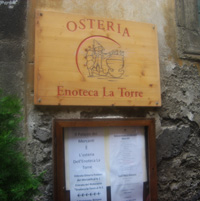 During a recent trip to Italy I had the opportunity to experience a sort of dining double whammy – my first encounter with a Michelin starred restaurant, and my first encounter with an unlikely Italian kitchen that carries out a unique version of “Fusion Cuisine.”
During a recent trip to Italy I had the opportunity to experience a sort of dining double whammy – my first encounter with a Michelin starred restaurant, and my first encounter with an unlikely Italian kitchen that carries out a unique version of “Fusion Cuisine.”
Travelling with son-in-law and accomplished home chef Rob Janssen, who did all the online research, we set out for a location in the region of Lazio not found on the usual tourist itineraries – for good reason. The town of Viterbo is an historic home of the papacy and traces origins to Roman times. It is well worth a visit but getting there is half the misery. The rest is finding a parking spot.
The restaurant in question is the Enoteca La Torre, Via della Torre 5, Viterbo IT. No reservations necessary since you can’t get there except on foot, by bike, helicopter or motorcycle. We were the only people who showed up for lunch that day.
The fusion cuisine is the work of young Chef Noda Kodaro a native of Japan who seems to have acquired all the necessary Italian culinary inputs to spin out successful combinations reflecting both ends of the world. Since he holds a Michelin star I am the last person to question his talent!
Meantime if you haven’t figured it out already I approach fusion cuisine from a factory-installed negative attitude. My idea of this style of cooking is to fuse Bolognese recipes with ingredients commonly used in Sicily. Until now I have never felt the urge to patronize a joint that advertises fusion (apologies to Ming Tsai). But in this case, as it turns out when all was said and done I came away with mixed feelings, mostly positive, that were dutifully realigned back to negative baseline with a shot or two of Grappa.
We chose the the 60 Euro/6 item tasting menu at chef’s discretion. We fastened seat belts.
 First, the wait staff recommended a local white wine which was offered to us at a fire sale price because it was the last remaining bottle. I guess they decided it wasn’t worth reordering. We grabbed it. It turned out to be very similar – to me at least – to Orvieto Classico from the neighboring region of Umbria, extremely smooth, slightly fruity and most pleasant. I’ll pretend I’m an expert wine critic and say it also had a hint of elderberry and porcini mushroom. Not hardly.
First, the wait staff recommended a local white wine which was offered to us at a fire sale price because it was the last remaining bottle. I guess they decided it wasn’t worth reordering. We grabbed it. It turned out to be very similar – to me at least – to Orvieto Classico from the neighboring region of Umbria, extremely smooth, slightly fruity and most pleasant. I’ll pretend I’m an expert wine critic and say it also had a hint of elderberry and porcini mushroom. Not hardly.
The starter amuse bouche (not pictured) courtesy of the chef was a very Italian-looking fritella, or fried doughball made with very Japanese Nori tempura. Very unique and great flavor! Why didn’t I think of that?
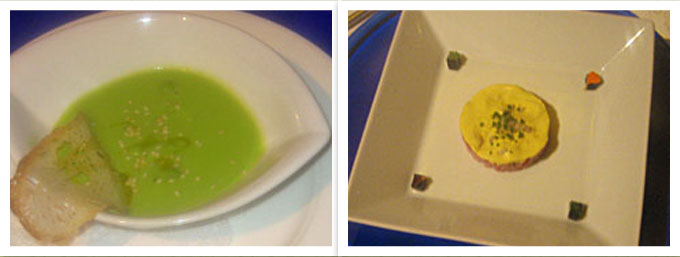 The show began with a pea soup perfectly smooth in texture but also including occasional bits of fresh peas. It was garnished with sesame seeds and a thin almost transparent crostino hanging over the side. Excellent. So far so good.
The show began with a pea soup perfectly smooth in texture but also including occasional bits of fresh peas. It was garnished with sesame seeds and a thin almost transparent crostino hanging over the side. Excellent. So far so good.
Next came a veal tartare topped with smoked mayonnaise and garnished with balsamic gelatin cubes. A bit milder in flavor than beef tartare as would be expected, but the mildness was counterbalanced by the smoked mayonnaise, which pumped up the overall taste experience a few notches. I was duly impressed.
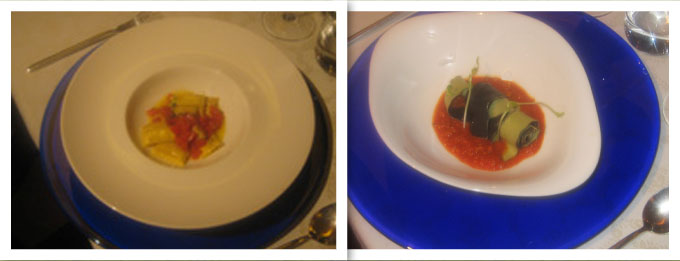 This was followed by the first of two pasta dishes: Doppi Ravioli Farciti con Salmone e Ricotta di Pecora con Burro ed Acciughe Mantecati. This is exactly how it appears on the menu. The translation takes only 20 minutes: it’s lamb’s milk ricotta and salmon stuffed double ravioli with whipped butter and anchovy. The ravioli were formed in a most unusual double pouch. The sauce consisted of a tomato concasse’ accented with anchovy. Not exactly a show stopper but the chef’s imaginative twist on the ravioli shape, in addition to the tongue-twisting name of the dish, was worth the visit just on that basis alone. I’m still on board at this point.
This was followed by the first of two pasta dishes: Doppi Ravioli Farciti con Salmone e Ricotta di Pecora con Burro ed Acciughe Mantecati. This is exactly how it appears on the menu. The translation takes only 20 minutes: it’s lamb’s milk ricotta and salmon stuffed double ravioli with whipped butter and anchovy. The ravioli were formed in a most unusual double pouch. The sauce consisted of a tomato concasse’ accented with anchovy. Not exactly a show stopper but the chef’s imaginative twist on the ravioli shape, in addition to the tongue-twisting name of the dish, was worth the visit just on that basis alone. I’m still on board at this point.
Then came a most unique two-tone example of pappardelle (not shown) , or extra wide noodles dressed with a tomato and finely chopped cuttlefish sauce. One side of the noodle is white like the traditional and the other is black, made with nero di sepia – ink from tiny octopus. Both types of pasta are widely found in Italy but nowhere will you find them fused together to yield the two-sided appearance. As the food writers love to say, the dish was a triumph of taste, texture and presentation! I’m betting this is the selection that earned Chef Noda his Michelin star. I have every intention to try to duplicate the feat sometime soon.
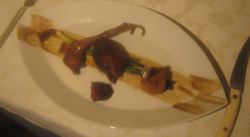 I thought we were on a roll. However from the sublime we abruptly came down to the ridiculous. The final serving was piccione glassato – balsamic glazed pigeon over whole wilted scallions. One piece of the little birdie consisted of a single slab of deep fried meat that included a wing, leg portion and what looked like two pigeon toes! How this cut was achieved is a surgical mystery.
I thought we were on a roll. However from the sublime we abruptly came down to the ridiculous. The final serving was piccione glassato – balsamic glazed pigeon over whole wilted scallions. One piece of the little birdie consisted of a single slab of deep fried meat that included a wing, leg portion and what looked like two pigeon toes! How this cut was achieved is a surgical mystery.
The other pieces were breast and thigh and gizzard. The breast was cooked for about 30 seconds or maybe not at all. I was being invited to eat raw pigeon. After a moment of hesitation I fearlessly ate as much as I could and handed over the rest to Rob who gobbled it up. I’ve heard of rare duck breast but not pigeon. The thigh and gizzard pieces hit the other extreme, cooked in liquid to the point of disintegration. No problem skipping this item on the next visit.
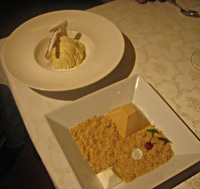 Fortunately the chef made a blazing comeback with a two- fisted dessert. One plate contained an extremely addictive semifreddo with clove flavored cream and chocolate hazelnut center, not found on the menu. An unadvertised bonus just for us. Alongside came a hazelnut flavored bavarian cream custard set in crumbled biscotti to resemble a partially completed pyramid in the Egyptian desert. It’s a good thing I’m missing a sweet tooth along with all the wisdoms otherwise I’d still be there demanding seconds and thirds. Being stuck in the savory universe it made me realize how much of the cooking world I’m missing. I never should have skipped the baking course at cooking school! But it’s never too late.
Fortunately the chef made a blazing comeback with a two- fisted dessert. One plate contained an extremely addictive semifreddo with clove flavored cream and chocolate hazelnut center, not found on the menu. An unadvertised bonus just for us. Alongside came a hazelnut flavored bavarian cream custard set in crumbled biscotti to resemble a partially completed pyramid in the Egyptian desert. It’s a good thing I’m missing a sweet tooth along with all the wisdoms otherwise I’d still be there demanding seconds and thirds. Being stuck in the savory universe it made me realize how much of the cooking world I’m missing. I never should have skipped the baking course at cooking school! But it’s never too late.
Check please. Given the production we were greeted with the total was less than expected.
Bottom line. If Enoteca La Torre is a good example of fusion cuisine one can expect to be exposed to a spectrum of flavors and combinations that by themselves don’t seem appropriate, but in the hands of an expert can produce amazing results as well as occasional flops. Qualified judge or not I was very impressed with Chef Noda and happily commend his restaurant to future visitors. While I did not become a convert I appreciated the experience and fully expect to sample this style of cooking again in the future – as long as Rob does the spade work and adjusts my attitude with a bottle of his vintage San Giovese.
